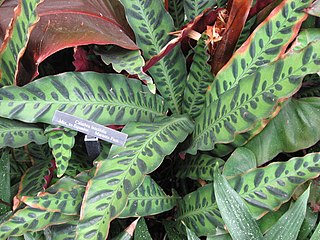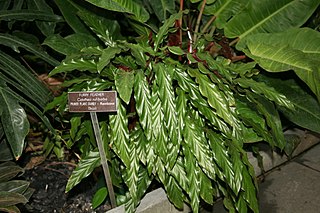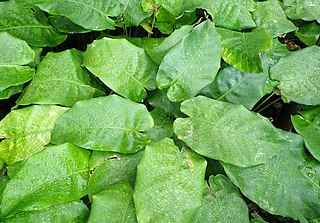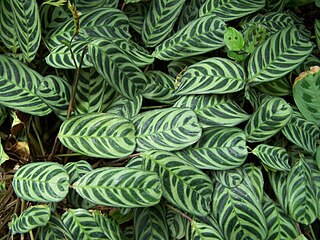
Roberto Burle Marx was a Brazilian landscape architect whose designs of parks and gardens made him world-famous. He is accredited with having introduced modernist landscape architecture to Brazil. He was known as a modern nature artist and a public urban space designer. His work had a great influence on tropical garden design in the 20th century. Water gardens were a popular theme in his work. He was deftly able to transfer traditional artistic expressions such as graphic design, tapestry and folk art into his landscape designs. He also designed fabrics, jewellery and stage sets.
Goeppertia dodsonii is a species of flowering plant in the Marantaceae family. It is endemic to Ecuador. Its natural habitat is subtropical or tropical moist lowland forests.

Goeppertia ecuadoriana is a species of flowering plant in the Marantaceae family. It is endemic to Ecuador. Its natural habitats are subtropical or tropical moist lowland forests and subtropical or tropical moist montane forests.
Goeppertia gandersii is a species of flowering plant in the Marantaceae family. It is endemic to Napo Province of Ecuador. Its natural habitats are subtropical or tropical moist lowland forests and subtropical or tropical moist montane forests.
Goeppertia libbyana is a species of flowering plant in the family Marantaceae, endemic to Napo Province of Ecuador. Its natural habitat is subtropical or tropical moist lowland forests. It has gained the Royal Horticultural Society's Award of Garden Merit.

Goeppertia veitchiana is a species of flowering plant in the Marantaceae family. It is endemic to Ecuador. Its natural habitats are subtropical or tropical moist lowland forests and subtropical or tropical moist montane forests.

Goeppertia makoyana, also known as peacock plant or cathedral windows, is a species of plant belonging to the genus Goeppertia in the family Marantaceae, native to Espírito Santo state of eastern Brazil. It has gained the Royal Horticultural Society's Award of Garden Merit.

Goeppertia loeseneri, the Brazilian star calathea, is a species of plant belonging to the Marantaceae family. It is native to Peru, northern Brazil, Colombia, and Ecuador. It can grow to a height of 1.2m.

Goeppertia insignis, the rattlesnake plant, is a species of flowering plant in the Marantaceae family, native to Rio de Janeiro state in Brazil.
Wittmackia burle-marxii is a species of flowering plant in the family Bromeliaceae, endemic to Brazil. It was first described in 1979 as Aechmea burle-marxii.

Goeppertia is a genus of flowering plants in the family Marantaceae, native to the New World Tropics. It contains 243 accepted species, many of which were until recently assigned to Calathea. It was first described by Nees von Esenbeck in 1831, who erroneously erected another genus Goeppertia in 1836, which has now been synonymized with Endlicheria. In 1862 August Grisebach described another genus Goeppertia; this has now been synonymized with Bisgoeppertia.

Goeppertia rufibarba, the furry feather or velvet calathea, is a species of flowering plant in the Marantaceae family, native to Bahia state of northeastern Brazil. The plant's common names are due to its fuzzy, fur-like underleaf texture, which is unusual in its genus. Common as a houseplant, the species requires warm temperatures, shade, and humidity to thrive, and may produce small yellow flowers. It has gained the Royal Horticultural Society's Award of Garden Merit.

Goeppertia kegeljanii is a species of flowering plant in the family Marantaceae. Native to Espírito Santo in Brazil, it is commonly also known by its synonym Calathea mosaica in the houseplant trade, due to the mosaic-like patterning on its leaves. As an ornamental plant, it is noted for its light green, oval leaves with a fine venation of yellow.

Ctenanthe burle-marxii, commonly known as the fishbone prayer plant, is a species of plant in the genus Ctenanthe native to Brazil. Its common name derives from the alternating pattern of stripes on its oval, pale green leaves, while its scientific name is honor of landscape architect Roberto Burle Marx. Similar to other plants in the family Marantaceae, it also has a propensity to close up its leaves at night, which is why it is also called a "prayer plant" like Maranta leuconeura. It grows well as a form of tropical ground cover, often in shade.

Goeppertia crocata, the saffron-coloured calathea or eternal flame plant, is a species of flowering plant in the family Marantaceae, native to Bahia and Espírito Santo states of eastern Brazil. It has gained the Royal Horticultural Society's Award of Garden Merit as a hothouse ornamental.

Goeppertia majestica, the majestic prayer plant, is a species of flowering plant in the family Marantaceae. It is native to Colombia, Ecuador, Peru, Bolivia, Guyana, and northern Brazil, and has been introduced to Venezuela. A large member of its genus, it has gained the Royal Horticultural Society's Award of Garden Merit.
Goeppertia mediopicta, the middle-stripe prayer plant, is a species of flowering plant in the family Marantaceae, native to Espírito Santo state in southeastern Brazil. It has gained the Royal Horticultural Society's Award of Garden Merit.

Philodendron burle-marxii is a plant in the genus Philodendron native to South America from Colombia to Ecuador and Brazil. Named after the landscape architect Roberto Burle Marx, it is one of over 50 plants that bear his name. This aroid can climb, and has green cordate leaves..The variegated Philodendron Burle marxii is its variety that displays leaves with yellow and white coloring.

Goeppertia fasciata, is a species of flowering plant in the family Marantaceae. Native to wet tropical areas of northeastern Brazil, it is occasionally kept as a houseplant. There appears to be a cultivar, 'Borrusica'.

Goeppertia burle-marxii is a species of plant in the Marantaceae family native to Brazil. It is named after Roberto Burle Marx. Common names for Goeppertia burle-marxii include "Blue Ice Calathea" and "White Ice Calathea".















